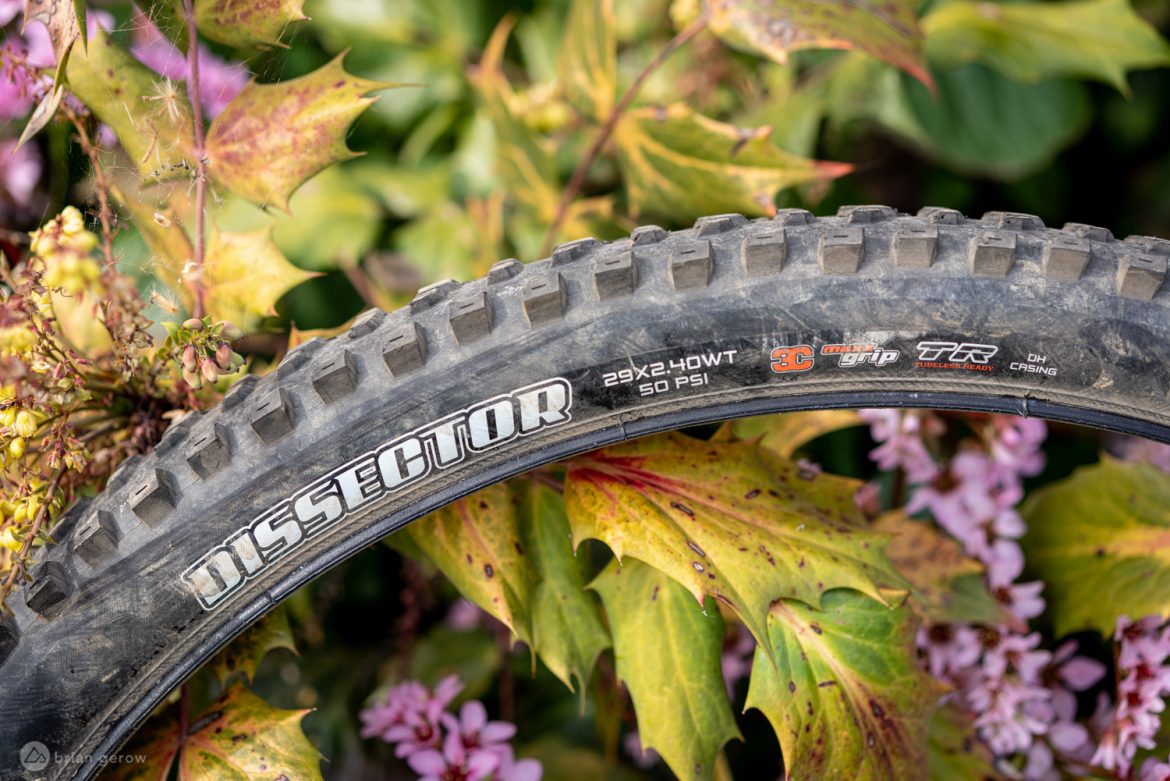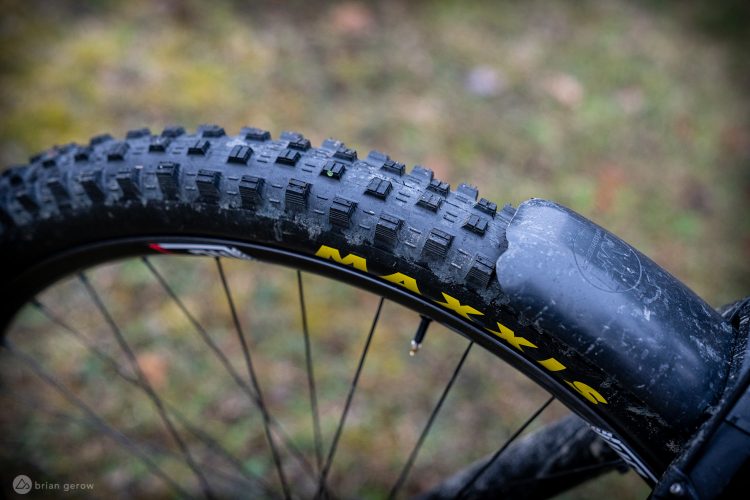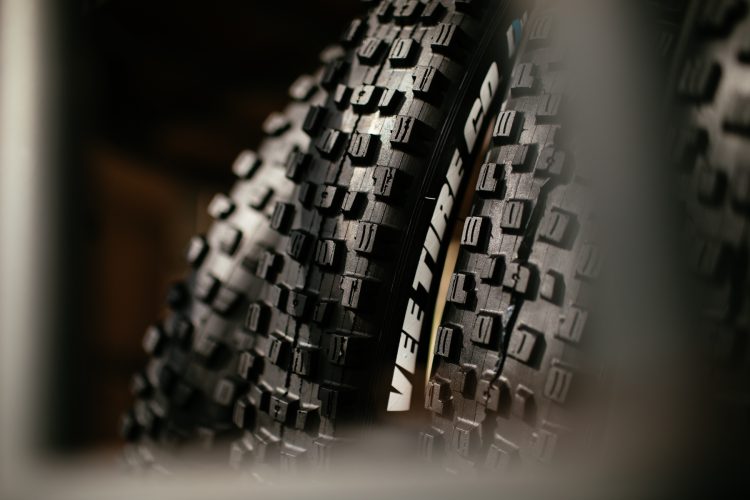
All-around tires are sweet for all-around riding with friends and enjoying the forest. Depending on the number of rock gardens in your area, and hours in the saddle, you might get away with a single set of rubber per season. Some folks even pride themselves on how little rear tread they can get away with, making a tire slide until its final destructive exhale.
That’s all good fun, but when it’s time to count milliseconds between some flailing plastic race tape, terrain-specific tires are the way to go. A few years ago Maxxis partnered with Aussie DH pro, Troy Brosnan, to develop a faster rolling tire that could still provide the grip riders need in dry and loose conditions. They named the resulting dust-muncher Dissector, and in short, it’s grippier than an Aggressor on the steep stuff and faster-rolling than a DHR II when the pedals are turning.
Our in-town trails have been dusty for a while this winter, so I decided to mount up the Dissector 29×2.4″ as a rear tire for a thorough test. I went with the DH casing for maximum puncture protection and a MaxGrip tread compound for obvious reasons. This combo tips the scale at 1,152g which is impressively lightweight for a dual-ply tire.
Maxxis Dissector Tire Pairings
I left the Maxxis Shorty V2 that I was already testing mounted at the helm, both in case of surprise spring rains and because I really like the predictability that chunky motocross tread provides.
The Dissector tread is rated for front or rear use, with numerous possible combinations. You could roll with a Dissector up front and an Aggressor, Minion Semi Slick, or a second Dissector rear tire for a super fast rolling setup. Alternatively, if the dust in your area digs ankle-deep, a Dissector rear paired with an Assegai, Shorty, or Minion DHF would do well to keep the wheels pointing mostly in the intended direction.

Maxxis Dissector Tire Casing and Tread
As with all Maxxis DH casings, this one popped into place quickly with a floor pump and managed to retain its air pressure and sealant well over the cold winter days. Thanks to the mid-height central lugs a cross-section profile of this tire on a 30mm wide rim is a smidge on the square side compared a Minion DHF, and measures quite close to the reported 2.4″ total width.
Center and cornering tread on the Dissector shares shapes with several other Maxxis designs, but on the trail it has a unique feel. It has a similar pedaling character to the Aggressor, with plenty of grip on the climb.
Alternating doubled and tripled middle lugs are all aggressively ramped for higher speed and are lightly siped to add flex. Those rows of soft lugs grip impressively well on steep trails to provide braking traction that’s similar to mounting a Minion DHF on the rear wheel, though with shorter knobs and lower weight the Dissector is even better at keeping the speedometer pinned.
Maxxis Aggressor vs. Maxxis Dissector
Maxxis touts the Aggressor as “the new standard in enduro tires,” and to compare the two treads again, both tires employ similarly burly shoulder knobs, while those on the Dissector seem a touch taller. That means it hooks up even better in flat turns, with no squirm to speak of when bolstered by the stout DH casing. The transition between central and shoulder knobs is smooth, and the grip breaks loose predictably when you ask it to.
While locked down in town we ride a lot of concrete-hard clay dirt with dust over the top. Some folks call it anti-grip. While any tire will eventually roll across the tiny marbles, this lower-profile pattern has done well to hold on where others fail. Traction with the Dissector is definitely reliable enough that I would mount one up front if I thought the weather would continue to agree.

We also have a good amount of off-camber singletrack in town, built to mimic the lean of the most popular local race venues. These out-sloped sections are where tire shape and shoulder knob strength matter most. A tire that’s too square won’t have enough purchase on sideways clay, and shoulder knobs that aren’t well supported will squirm around and lose the line before they rip off completely.
The Maxxis Dissector profile has just the right amount of curve to allow it to grip off-camber, hard-packed earth and maintain forward momentum. On looser or wet, off-camber trails I would go for a different tire, since something a little more square tends to cut into the soft dirt and hold a line better.
They can’t all be sunny days, and the Maxxis Dissector tire also does well in damp conditions. While I would swap it out before heading into a truly wet shred, it’s not a terrible option for riding a few days post-rainfall. The lugs are far enough apart that it sheds mud well, and performs similarly to a half-worn DHR II in moist soil. The MaxxGrip compound will stick to almost anything, provided it can clear dirt fast enough to make that connection, and it should be just fine on summer rides or races with a chance of rain.
Durability is not the first concern with tread compounds like this one. The MaxxGrip rubber is designed to hold on tight, and regain traction quickly, and it does both of those things at the cost of tread longevity. While the central knobs are now all double-ramped from heavy braking, the soft tread has held up better than expected.
The tire isn’t missing any shoulder knobs, despite a lot of laps on fast and rocky descents with plenty of almost-pavement-clay skidding into steep turns. Either Maxxis has improved something here or my riding style has evolved, as a few years ago I was regularly ripping the side knobs from their tires.

As we learned in the “How do MTB Tires Grip?” article published earlier this year, heavy DH casings are designed to feel good and work well at high speeds. While this dual-ply casing undoubtedly feels better when repeatedly pummeled by high-velocity impacts, it’s not as harsh at low speeds as some gravity carcasses can be. If you live in a pointy place where DH casings are the only way, these definitely feel better than a lot of the heavyweight competition.
Conclusion
Finally, I wasn’t able to poke a noticeable hole in the DH casing this winter, though there could have been some smaller punctures that the neon Muc-Off sealant took care of. I definitely heard multiple rim strikes, and since I’m testing carbon rims I didn’t run an insert with this tire, but I never once had to pull out the plug kit or pump. In fact, the Maxxis Dissector made it through the whole test with the same sealant, and it wasn’t quite ready for a top-up when I removed the bead.
Given the massive number of tread patterns in the Maxxis lineup, I would argue that they could scrap the Aggressor model and replace it with the Dissector.
With a similar feel at high speeds, better overall grip, and a wider range of usability, the Dissector seems the superior pattern all around. It can also be used as a front tread, where the Aggressor is a rear-only design, placing it a full step above the brand’s other fast and dry options.
- Price: $65 to $100 depending on size and construction
- Available at Jenson USA and other retailers



















